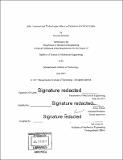After treatment and turbocharger effects on emissions of a diesel engine
Author(s)
Schmidt, Kristina (Kristina E.)
DownloadFull printable version (14.18Mb)
Other Contributors
Massachusetts Institute of Technology. Department of Mechanical Engineering.
Advisor
Amos Winter.
Terms of use
Metadata
Show full item recordAbstract
An experimental study on the effects of after treatments and a turbocharger on emissions of a single cylinder diesel engine. The study measured the concentration of CO, CO2, HC, NO, NO2, and NOx. Tests on the engine were performed at different engine loads and engine speeds. The engine power ranged from 0 to 9 HP, and the engine speed ranged from 1500 to 3500 rpm. Emissions were characterized in terms of engine speed, engine power, and exhaust temperature. The results showed that the optimal strategy for emission reduction was to combine the Diesel Oxidation Catalyst and the Diesel Particulate Filter to form a Continuously Regenerating Trap. These after treatments would be combined with the use of a turbocharger and air capacitor to ensure that the back pressure doesn't take away too much power and increase fuel consumption.
Description
Thesis: S.B., Massachusetts Institute of Technology, Department of Mechanical Engineering, 2017. DISCLAIMER NOTICE: The pagination in this thesis reflects how it was delivered to the Institute Archives and Special Collections, Massachusetts Institute of Technology. Cataloged from PDF version of thesis. Includes bibliographical references.
Date issued
2017Department
Massachusetts Institute of Technology. Department of Mechanical EngineeringPublisher
Massachusetts Institute of Technology
Keywords
Mechanical Engineering.